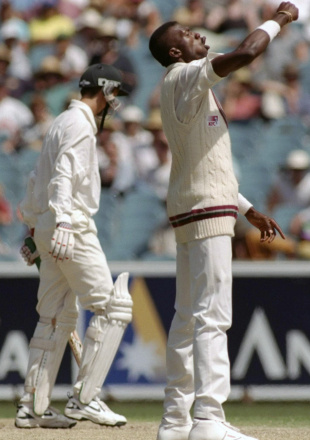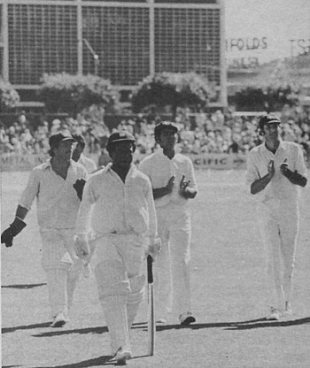West side story
At the WACA, they say, batsmen can leave alone balls pitched at a good length. Some tellable pitchside tales from Wild West Perth
Dileep Premachandran
16-Jan-2008
|
|

| |
To understand just how frightening the WACA used to be for batsmen, you only have to watch the footage of Curtly Ambrose and Ian Bishop in their prime in 1992-93. Australia had been denied a first series win in a generation in Adelaide, and the teams had come to Perth all square. And although Australia lost Justin Langer early, caught behind off Bishop, they were pretty handily placed at 58 for 1 when the match and series went pear-shaped. Again, it was Bishop, targetting Steve Waugh's body, and the diffident glance was taken by Junior Murray.
The initial incisions may have had a Trinidadian flavour to them, but it was all Antiguan aggression after that. Ambrose had enjoyed a stellar series, beating Malcolm Marshall's record for most wickets in a series against Australia, and with the flick of an imaginary switch, he produced one of the great spells of fast bowling seen anywhere.
Mark Waugh nicked one behind, and David Boon was helpless against one that lifted off a good length. When Allan Border was squared up and caught behind first ball, the innings was in disarray. But Ambrose was far from done. Of the seven wickets he took, conceding just one run, six were caught by the keeper or the slip cordon. The seventh, Merv Hughes, perished to an ambitious hoick that was taken at cover.
It wasn't the fastest spell you'll ever see, but it was an object lesson in what length to bowl on the fastest pitch in the world. Ambrose was never too short, and his height and the steepling bounce meant that even balls that landed on a driving length were too hot for batsmen to handle.
After Australia succumbed just before lunch on the third day, the curator was sacked. It was West Indies' fourth win in four attempts at the WACA, and it was small wonder that Border used to regard Perth games against the men in maroon caps as an away fixture.
The next match West Indies played here would mark the end of an era. They arrived having lost a series in Australia for the first time since 1975-76, but there would be one final sting in the tale from the last of the great assembly line of the Caribbean quicks.
Only Mark Waugh and Michael Bevan offered resistance as Ambrose and Bishop again triggered a slide to get Australia all out for 243. In reply, Brian Lara produced one of his greatest Test hundreds, the equal of his glorious 277 at the SCG four years previously. His 132 was the difference between the sides, and by the time Australia wiped off the deficit, they were eight wickets down.
This time, the destroyer in chief was another legend, Courtney Walsh, who ignored a hamstring injury to bowl 20 overs on the trot for his five wickets. West Indies haven't won a game in Australia since, and the game is immeasurably poorer for their decline.
The first sign of their years of plenty, when they were almost invincible, had also been glimpsed at the WACA in Greg Chappell's first series as Australian captain. Australia had won comfortably in Brisbane, and Ian Chappell's scintillating 156 gave them a decent total of 329 on a lightning-fast pitch in Perth.
At least, it appeared decent until Roy Fredericks went to work. Kid Cement, as Fredericks was known for his courage against fast bowling, got away with a miscued hook for six off Dennis Lillee, and there was seldom a false stroke afterwards as a four-pronged attack of Lillee, Jeff Thomson, Gary Gilmour and Max Walker was put through the mincer. Fredericks hooked, pulled, cut and drove with awesome power and imperious timing on his way to 169 from 145 balls. Such was the awe it inspired that Clive Lloyd's regal 149 (off just 186 balls) became almost an afterthought. Viv Richards, who made just 12 himself, called it a "privilege" to be there, to witness the best innings that he ever saw.
|
|

| |
Greg Chappell's take on it is slightly different. "Fredericks played very well, but to be fair we bowled badly," he says. "We were too short most of the time and too wide the rest. It was a very good pitch for fast bowlers, hard and well grassed, but good for the batsmen too if you gave them room or length to work with. The West Indies didn't give us the room and their extra bounce made it difficult. It was the perfect wicket for their combo of shot making and tall, fast bowlers.
"They were too good over the three to four days of the Test. Ian Chappell was the only one who batted well for us and his innings was probably the better of the two, because he was made to work harder than we made Fredericks work. We couldn't have bowled more to suit him if we had tried."
Australia would win the four remaining Test matches, though, with West Indies unable to cope with the pace barrage, the sledging and what Richards called blatantly racist abuse from sections of the crowds. Chappell, though, regards that 5-1 series win as one of the high points of Australia's cricket history, though he qualifies it by saying: "I think the series we drew with them in the West Indies during WSC [World Series Cricket] when their bowling was more mature would rank as highly."
As for India, this has seldom been a happy hunting ground. It's 16 years since they last played here, a one-sided match remembered only for the bright kernel of hope to emerge from the embers of a defeat triggered by one of cricket's quintessential journeymen. "Ripping through a line up containing the likes of Sachin Tendulkar, Dilip Vengsarkar, Kapil Dev and Mohammed Azharuddin takes some doing," says Michael Whitney, looking back on his 7 for 27 from 12.1 overs that pushed India to a 300-run defeat after Krishnamachari Srikkanth and Navjot Singh Sidhu had put on 82 for the first wicket in the second innings.
Tendulkar still regards that first-innings 114 (161 balls) as one of his finest hundreds, and those who have watched him since 1989 would find it hard to pick a knock that has eclipsed it. Kiran More, who added 81 for the ninth wicket with him, had the best view in the house. "For any batsman to play at Perth for the first time is not easy," he says. "He played some shots straight through the covers off the back foot. On that pitch, if you play on the back foot, most of the shots go square and fine, but he was playing through extra cover and cover. Sachin's a short person, and those shots are difficult to play, but he was doing it so easily."
The best assessment of Tendulkar's masterpiece came from an Australian with a gift for the pithy phrase. Merv Hughes' language may usually have been colourful, even blue, but he was spot on when he turned to Border and said: "This little prick's going to get more runs than you, AB."
Dileep Premachandran is an associate editor at Cricinfo